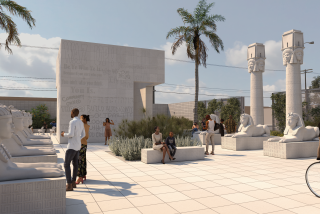Like King, Sculptor Had a Dream : Monument: Artist Charles Dickson will see tribute to slain civil rights leader unveiled today.
At about the same time that Martin Luther King Jr. delivered his “I Have a Dream” speech in Washington, D.C., Charles Dickson was learning how to carve wood in a shop class at Markham Middle School in Watts.
Today, Dickson will watch as his tribute to the civil rights leader--a 14-foot bronze and concrete sculpture--is unveiled in a Watts ceremony commemorating King’s birthday.
“For the last 30 years I’ve trained and studied for this,” Dickson said as he stood in an Inglewood foundry, helping a welder put the finishing touches on the sculpture. “It’s something I can do for my community as a creative process to show that community can give back to community.”
The work is the culmination of a dream for the affable 43-year-old sculptor, who beat out 35 other artists in a competition sponsored by the city Community Redevelopment Agency to create the memorial.
Appropriately, the memorial will stand in a corner of the Martin Luther King Jr. Shopping Center, at 103rd Street and Compton Avenue. The late civil rights leader toured the site just days after the 1965 Watts riots, when it was still a pile of rubble and ashes called “Charcoal Alley.”
This past weekend, Dickson and a team of six assistants were working feverishly to finish the $64,000 memorial in time for this morning’s unveiling.
Dickson said his design for the memorial was inspired by a desire to convey King’s strength and the aspirations of the civil rights movement.
At the center of the sculpture rises a 1,200-pound bronze hand that is releasing a hummingbird into flight. The hand rests upon a large platform shaped like a podium or pulpit.
The entire text of the 1963 “I Have a Dream” speech has been engraved on the platform’s marble slabs. Two sides of the platform join to form a large wedge. The torsos of civil rights marchers emerge in concrete relief sculptures from each side of the wedge.
“I saw King and his marchers creating this wedge,” Dickson said. “The wedge is a very powerful tool. With that power of unity, they were able to change things.”
The podium is there “because I always saw King as an orator, speaking to the multitudes,” Dickson said. “The hand is like this magical instrument that lets people see these new possibilities.” And the hummingbird is a symbol of freedom common to many African cultures.
The King memorial will help commemorate Watts’ place in the history of the civil rights struggle, said John Outterbridge, director of the Watts Tower Cultural Center. The 1965 Watts rebellion--as it is called by local residents--was the first in a series of urban insurrections that shed light on the plight of blacks in America’s major cities.
“The rebellion (of 1965) was the first violent confrontation,” Outterbridge said. “It was a pivotal place in the civil rights era. We have to acknowledge that it was a period that introduced change, a social and political transition that was most necessary in America.”
At the time of the riots, Dickson was a high school student watching as the Watts commercial district burned. “I was part of it, everyone was part of it,” he said.
Dickson won the commission because the jury of arts professionals and Watts residents was impressed by his strong links to the community, said Mickey Gustin, arts planner for the CRA.
“He has stayed in the community,” Gustin said. “He grew up with the pressures of trying to survive in the aftermath of the rebellion.”
Dickson’s love for art grew stronger while he was growing up in South-Central Los Angeles. As a student at Fremont High School, he sculpted and carved anything he could get his hands on. Later, he made friends with the artists who thrived in the African-American art scene of the late 1960s and ‘70s.
More to Read
The biggest entertainment stories
Get our big stories about Hollywood, film, television, music, arts, culture and more right in your inbox as soon as they publish.
You may occasionally receive promotional content from the Los Angeles Times.











